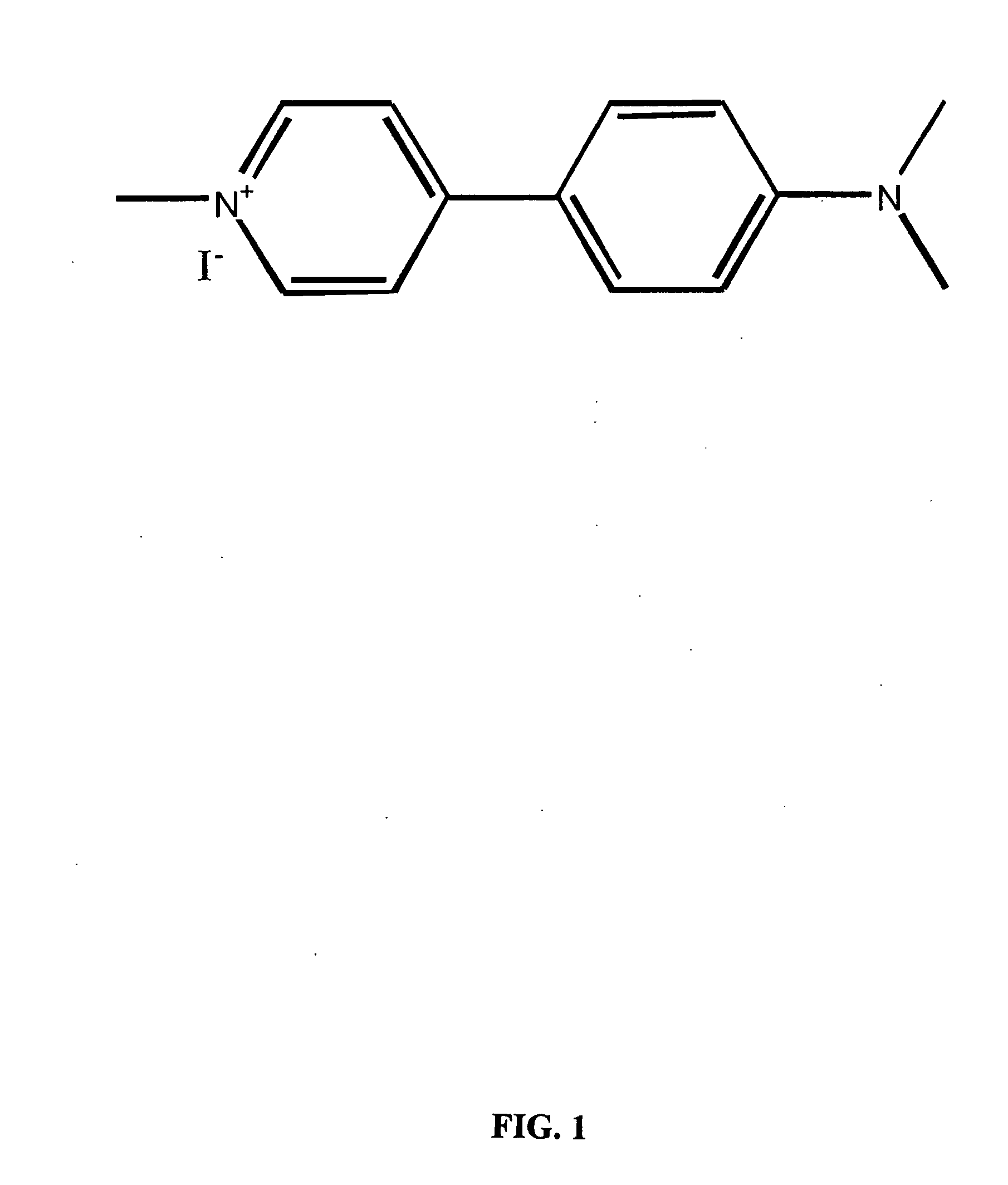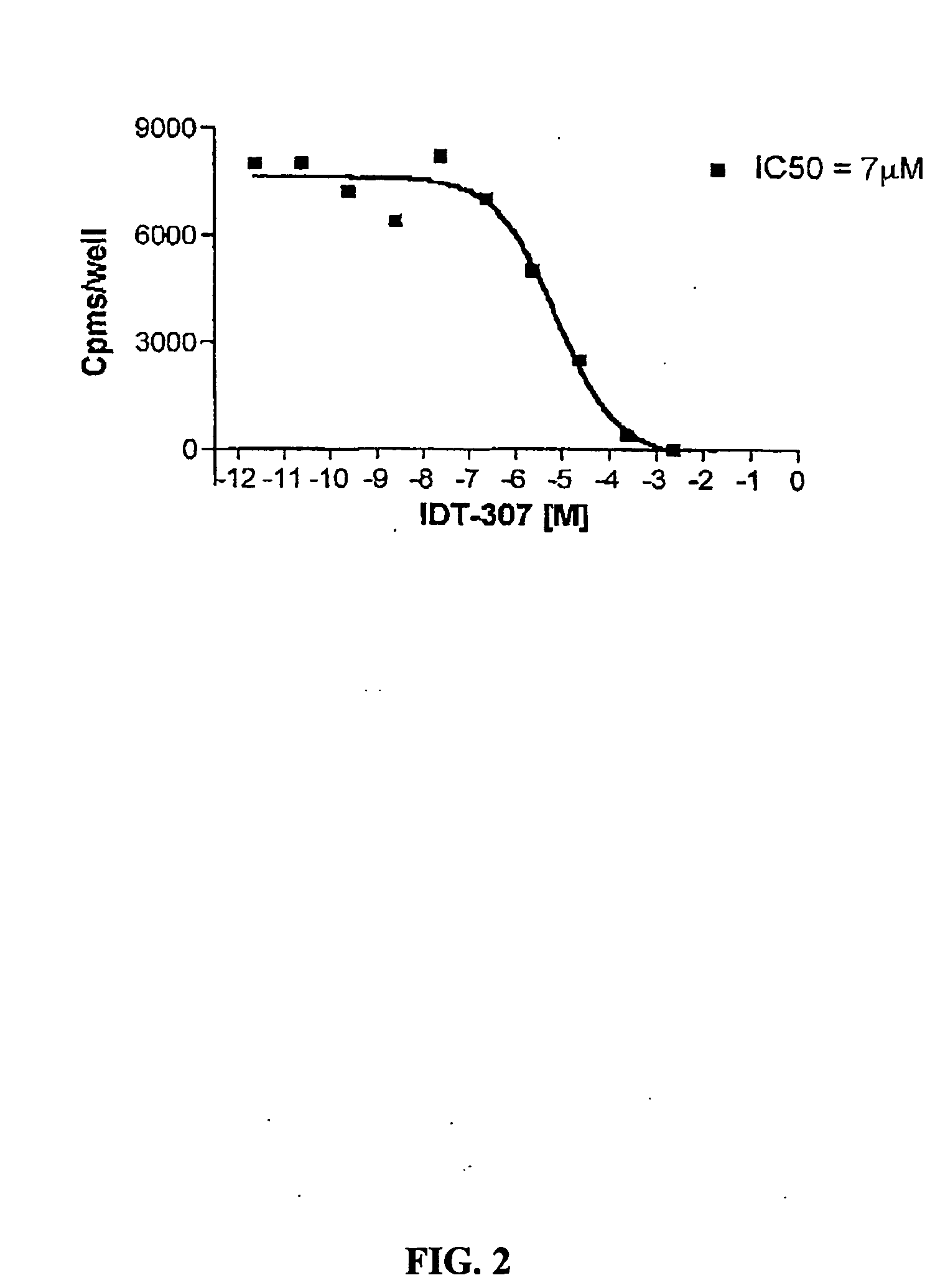Fluorescent substrates for neurotransmitter transporters
a neurotransmitter and fluorescent substrate technology, applied in the field of neurophysiology, can solve the problems of poor time and spatial resolution, limited methods, and difficult to achieve the effect of avoiding any possible direct or indirect effect on a cell
- Summary
- Abstract
- Description
- Claims
- Application Information
AI Technical Summary
Benefits of technology
Problems solved by technology
Method used
Image
Examples
example 1
Materials and Methods
[0100] IDT307. The synthetic scheme used to synthesize IDT 307 is outlined in Scheme 1, above. Briefly 4-bromo-pyridine was converted to diethyl (4-pyridyl)borane (I) via a reaction of 4-lithiopyridine with diethylmethoxyborane. Resulting in a 20% yield of (I). This was coupled to 4-dimethyl amino bromo benzene using the method developed by Ishikura (Ishikura et al., 1985). Tetrakis(triphenylphosphine) palladium(0) catalyst was added to (4-pyridyl)borane, tetrabutylammonium bromide, powdered KOH and 4-dimethyl amino bromo benzene. This mixture was dissolved in THF and heated at reflux under a nitrogen atmosphere. Resulting in N,N-dimethyl-4-(pyridine-4-yl) aniline (II) in a 17% yield. The pyridine ring was methylated by refluxing (II) in acetonitrile in the presence of methyl iodide and IDT 307 (III) crystallized upon cooling resulting in a 65% yield of the desired compound.
[0101] Diethyl (4-pyridyl borane) (I). N-Butyllithium (1.6M in hexanes, 20 ml) was adde...
example 2
[0104] IDT321. Was prepared by refluxing N,N-dimethyl-4-(pyridine-4-yl) aniline (II) in acetonitrile in the presence of ethyl iodide. Upon cooling diethyl ether was added and the product crystallized resulting in a 18% yield of 4-(4-(dimethylamino)phenyl)-1-ethylpyridinium iodide (IDT321) (IV).
[0105] 4-(4-(dimethylamino)phenyl)-1-ethylpyridinium iodide (IDT321) (IV). N,N-dimethyl-4-(pyridine-4-yl) aniline (0.1 g, 5.5 mmols) was dissolved in acetonitrile (50 ml) and ethyl iodide (4 ml) was added. The mixture was heated at reflux for 4 hours then cooled to ambient temperature. Diethylether (50 ml) was added IDT321 (0.035 g, 0.9 mmols) crystallized upon standing and was removed via filtration. 1H NMR (DMSO-d6) δ 1.50 (t, 3H), 3.40 (s, 6H), 4.50 (q, 2H), 6.95 (d, 2H), 8.05 (d, 2H), 8.35 (d, 2H), 8.90 (d, 2H).
example 3
[0106] IDT322. Was prepared by refluxing N,N-dimethyl-4-(pyridine-4-yl) aniline (II) in acetonitrile in the presence of ethyl iodide. After which the solution was cooled to room temperature. Ether was added and the product crystallized resulting in a 29% of 4-(4-(dimethylamino)phenyl)-1-propylpyridinium iodide (IDT322) (V).
[0107] 4-(4-(dimethylamino)phenyl)-1-propylpyridinium iodide (IDT322) (V). N,N-dimethyl-4-(pyridine-4-yl) aniline (0.2 g, 11 mmols) was dissolved in acetonitrile (50 ml) and propyl iodide (4 ml) was added. The mixture was heated at reflux for 4 hours then cooled to ambient temperature. Diethylether (50 ml) was added IDT322 (0.11 g, 2.9 mmols) crystallized upon standing and was removed via filtration. 1H NMR (DMSO-d6) δ 1.40 (t, 3H), 1.92 (q, 2H) 3.40 (s, 6H), 4.45 (t, 2H), 6.85 (t, 2H), 8.02 (d, 2H), 8.39 (d, 2H), 8.82 (d, 2H).
PUM
 Login to View More
Login to View More Abstract
Description
Claims
Application Information
 Login to View More
Login to View More - R&D
- Intellectual Property
- Life Sciences
- Materials
- Tech Scout
- Unparalleled Data Quality
- Higher Quality Content
- 60% Fewer Hallucinations
Browse by: Latest US Patents, China's latest patents, Technical Efficacy Thesaurus, Application Domain, Technology Topic, Popular Technical Reports.
© 2025 PatSnap. All rights reserved.Legal|Privacy policy|Modern Slavery Act Transparency Statement|Sitemap|About US| Contact US: help@patsnap.com



